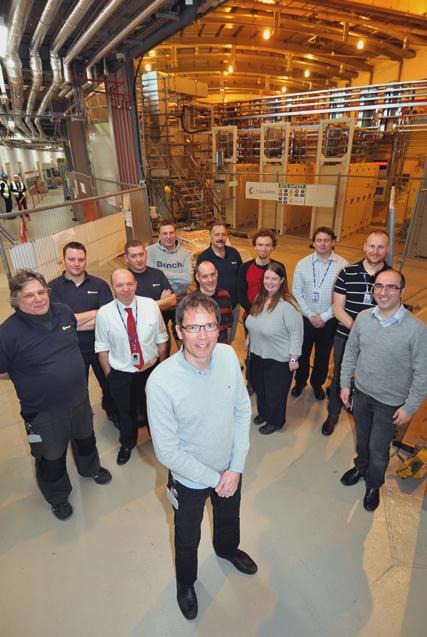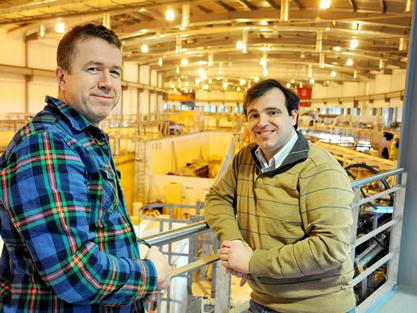Keep up to date with the latest research and developments from Diamond. Sign up for news on our scientific output, facility updates and plans for the future.
A new type of Macromolecular Crystallography (MX) beamline will replace beamline I02 by the end of 2016. The new beamline will be the first of its kind solely dedicated to data collection directly from  crystallisation experiments in situ – a new approach that MX beamlines at Diamond have pioneered over recent years. The new beamline, VMXi, will be highly automated and users will access beamline functionality remotely.
crystallisation experiments in situ – a new approach that MX beamlines at Diamond have pioneered over recent years. The new beamline, VMXi, will be highly automated and users will access beamline functionality remotely.
Crystallisation is often a very long and iterative process where initial promising conditions are optimised until crystals suitable for the diffraction experiments are obtained. For challenging biological systems this crystallisation process can be very complex indeed. This is where the new MX beamline can help our users by hosting crystallisation experiments at the beamline and enable direct diffraction analysis without any additional manipulation, thus preserving the crystal integrity - and provide immediate feedback on crystal quality and parameters, even in the case of microcrystals (2-5 μm). With this insight, users can progress their crystallisation experiments in a more rational way – and for some projects finally make some progress.
Building works for the new beamline is well underway in Zone 4 and installation of the new beamline experimental station will start during the summer 2015. While the new beamline is being developed the existing I02 continues to deliver beam for the MX user community.
An X-ray beamline for MX that is aimed at atomic structure determination in cases where the production of significant quantities of protein material and crystals is problematic. Indeed this is the case for many challenging protein complexes and medically important macromolecules that yield only very small crystals.
Indeed this is the case for many challenging protein complexes and medically important macromolecules that yield only very small crystals.
The X-ray beam size on VMXm will be less than 0.5 microns and with the use of novel X-ray optics and electron beam imaging methods we will be able to precisely align the tiniest protein crystals into this X-ray beam, in vacuo, and measure X-ray diffraction data from them. The ability to tune the X-ray energy will allow us to obtain additional information from heavy atoms within the macromolecules to aid in structure determination by multicrystal SAD or MAD methods. In many ways VMXm will be a hybrid X-ray/cryoEM instrument making use of methods for sample preparation from cryo-electron-microscopy, imaging from scanning electron microscopy and diffraction data collection methods from X-ray crystallography.
VMXm is currently under construction and is scheduled for first user operations towards the end of 2017.
> Gwyndaf Evans, Principal Beamline Scientist for VMXm, is leading a major new MX software project - DIALS - which will become the standard for all crystallograpy beamlines at Diamond. Read more in our spring software feature, 'Into the data bazaar'.
XPDF (beamline I15-1) will be applicable to a diverse range of disciplines such as materials chemistry, solid-state physics, earth sciences and pharmaceuticals, since the importance of understanding local structure is becoming increasingly apparent in these areas. XPDF will be dedicated to the measurement of X-ray pair distribution function (PDF) data. The PDF is the histogram of interatomic distances within a material and provides quantitative information on the local structure. Researchers will be able to study the local structure of crystalline, semi-crystalline and amorphous solids and liquids.
 PDF techniques have been used for many years to study the shortrange structure of disordered solids and liquids. However, unlike complementary short-range probes like EXAFS and NMR, PDF data can also give information on medium- to long-range order (> 100 Å). In recent years PDF techniques have been increasingly applied to crystalline materials and nanomaterials. For many crystalline materials the local structure differs from the average structure (as determined through traditionally crystallographic techniques), and often it is these differences that give rise to observed physical properties such as ferroelectricity or colossal magnetoresistance.
PDF techniques have been used for many years to study the shortrange structure of disordered solids and liquids. However, unlike complementary short-range probes like EXAFS and NMR, PDF data can also give information on medium- to long-range order (> 100 Å). In recent years PDF techniques have been increasingly applied to crystalline materials and nanomaterials. For many crystalline materials the local structure differs from the average structure (as determined through traditionally crystallographic techniques), and often it is these differences that give rise to observed physical properties such as ferroelectricity or colossal magnetoresistance.
The PDF is measured as the Fourier transform of the total scattering function, S(Q), collected to large values of the scattering vector, Q. It is essential to measure to maximum Q values that far exceed those traditionally used in crystallography (typically <10 Å−1) in order to provide the best possible PDF resolution. XPDF will use high energy X-rays and large area detectors to measure X-ray scattering data up to a maximum Q of 40 Å−1. The specially designed endstation will give the low background scattering contribution necessary for accurate PDF data. However, XPDF will not only be able to measure PDF data. Two area detectors will be used which can be independently positioned close to the sample (for PDF data collection) or up to 1 metre away from the sample for higher resolution Bragg diffraction data. It is expected that many researchers will make use of this flexibility to simultaneously collect PDF, S(Q) and Bragg data.
The XPDF beamline is being built as a side-station to the I15 Extreme Conditions beamline. The optical design will allow both beamlines to operate concurrently and quasi-independently. Sample environments will initially focus on high-throughput capillary samples, including variable temperature experiments from 85 K to 1200 K. The flexibility of the sample station should facilitate the development and installation of more complex transmission geometry sample environments.
XPDF will be the first dedicated X-ray PDF beamline in Europe; the complete package of hardware and PDF processing software will provide an unparalleled user-friendly PDF beamline. 2015 will see the commissioning of the monochromator, diagnostics and endstation. XPDF is expecting to announce a first call for proposals in April 2016.
A full update will be given in a Pair Distribution Function workshop at the annual Diamond Synchrotron Radiation User Meeting (2nd-3rd September 2015).
Diamond Light Source is the UK's national synchrotron science facility, located at the Harwell Science and Innovation Campus in Oxfordshire.
Copyright © 2022 Diamond Light Source
Diamond Light Source Ltd
Diamond House
Harwell Science & Innovation Campus
Didcot
Oxfordshire
OX11 0DE
Diamond Light Source® and the Diamond logo are registered trademarks of Diamond Light Source Ltd
Registered in England and Wales at Diamond House, Harwell Science and Innovation Campus, Didcot, Oxfordshire, OX11 0DE, United Kingdom. Company number: 4375679. VAT number: 287 461 957. Economic Operators Registration and Identification (EORI) number: GB287461957003.